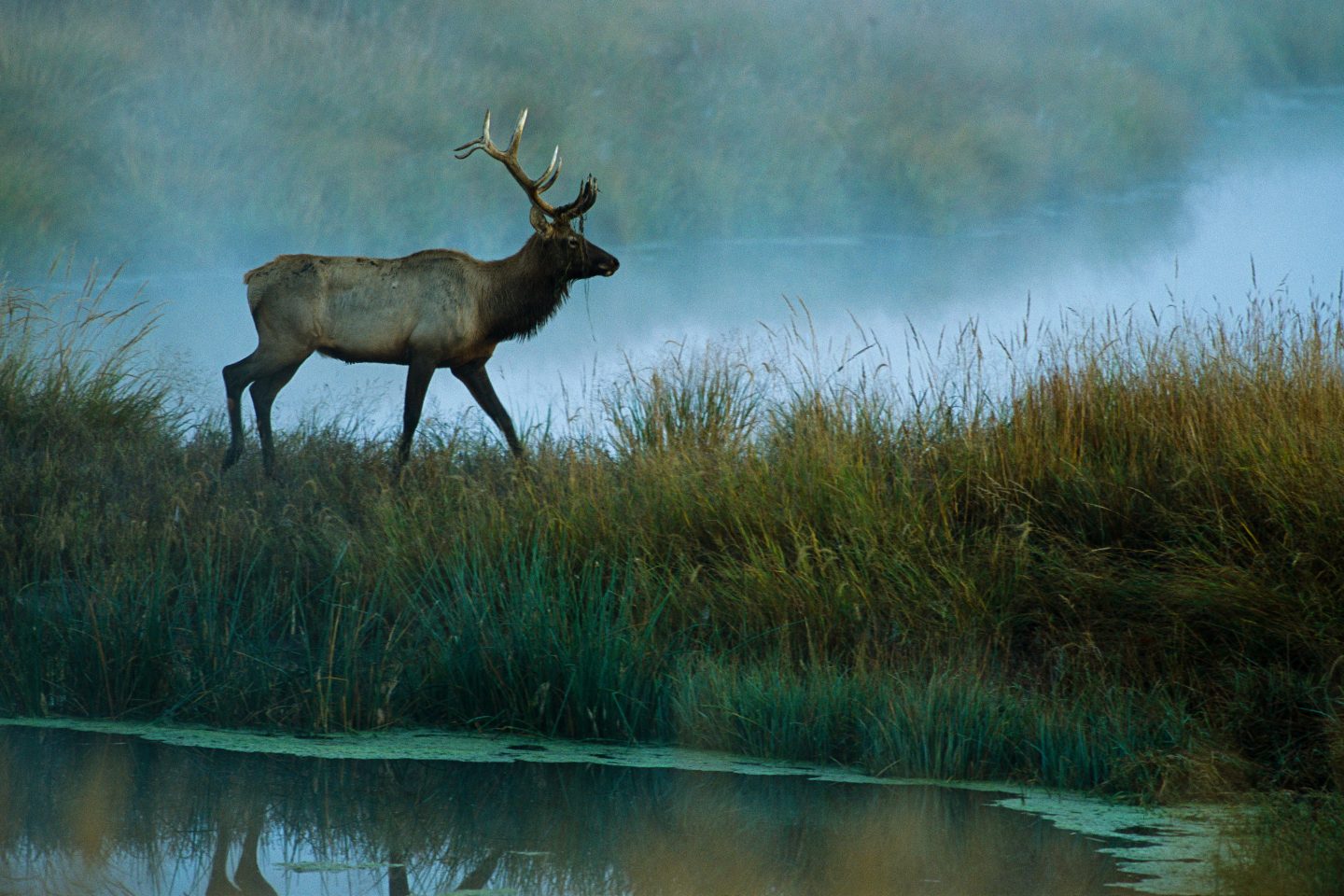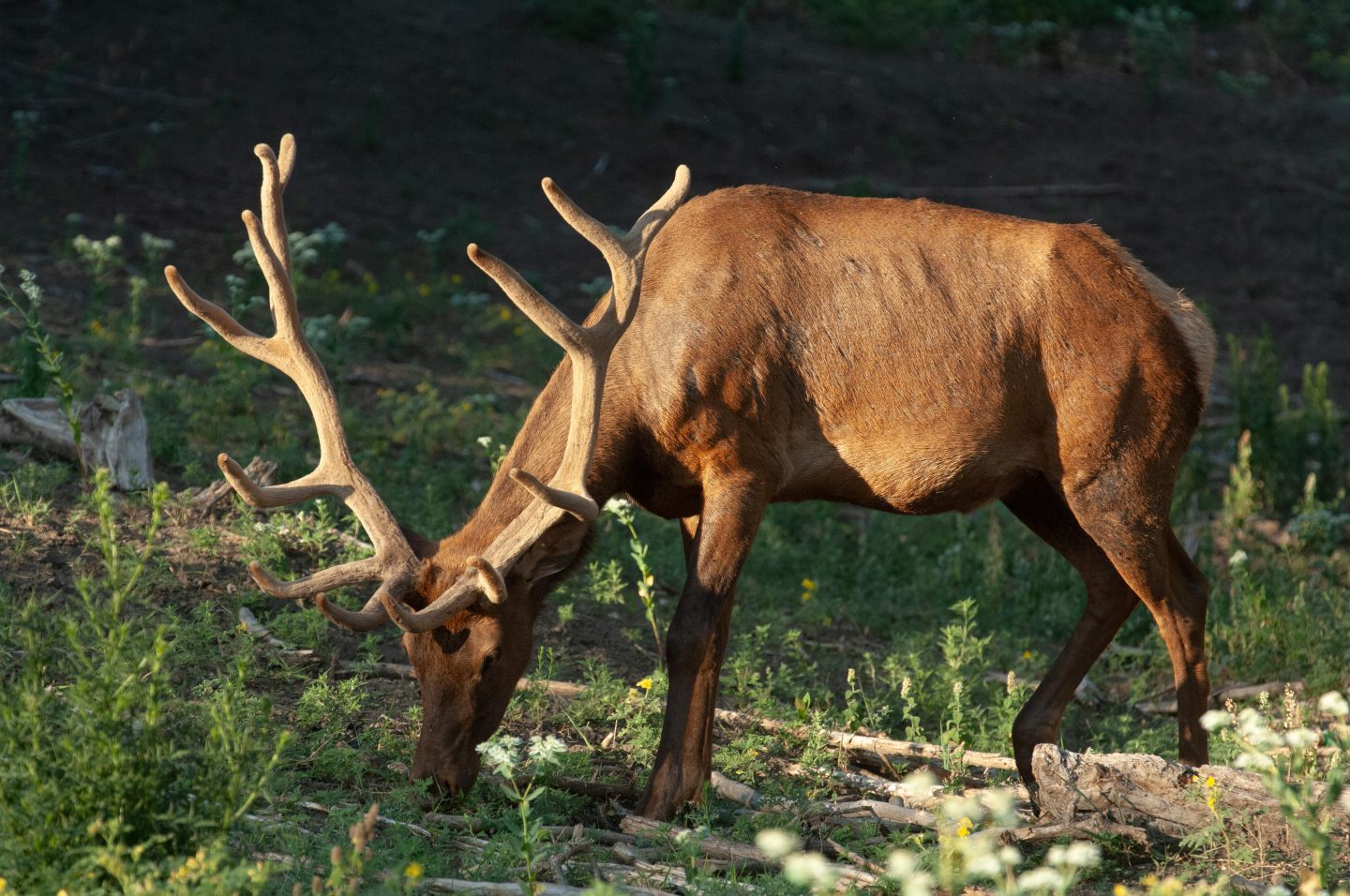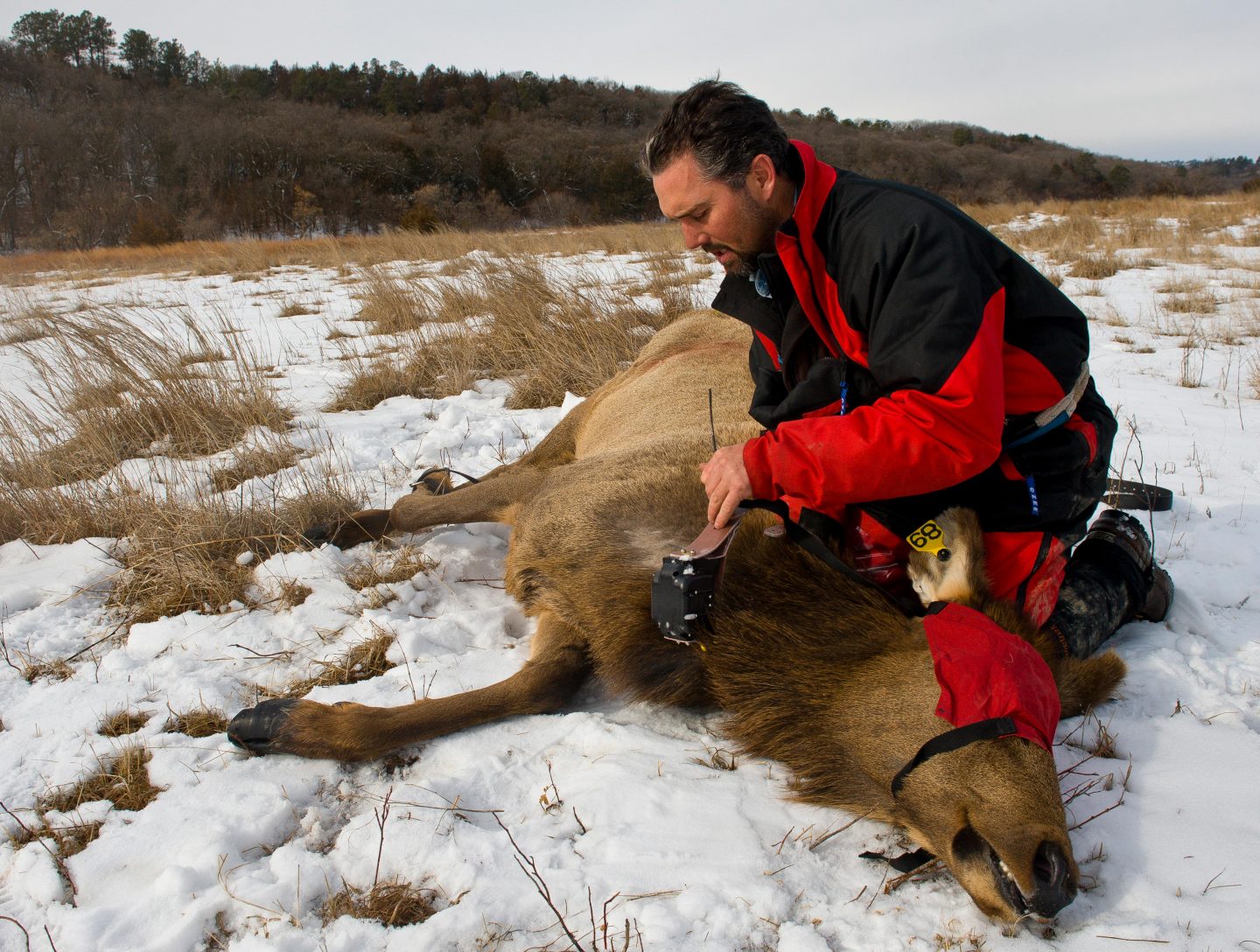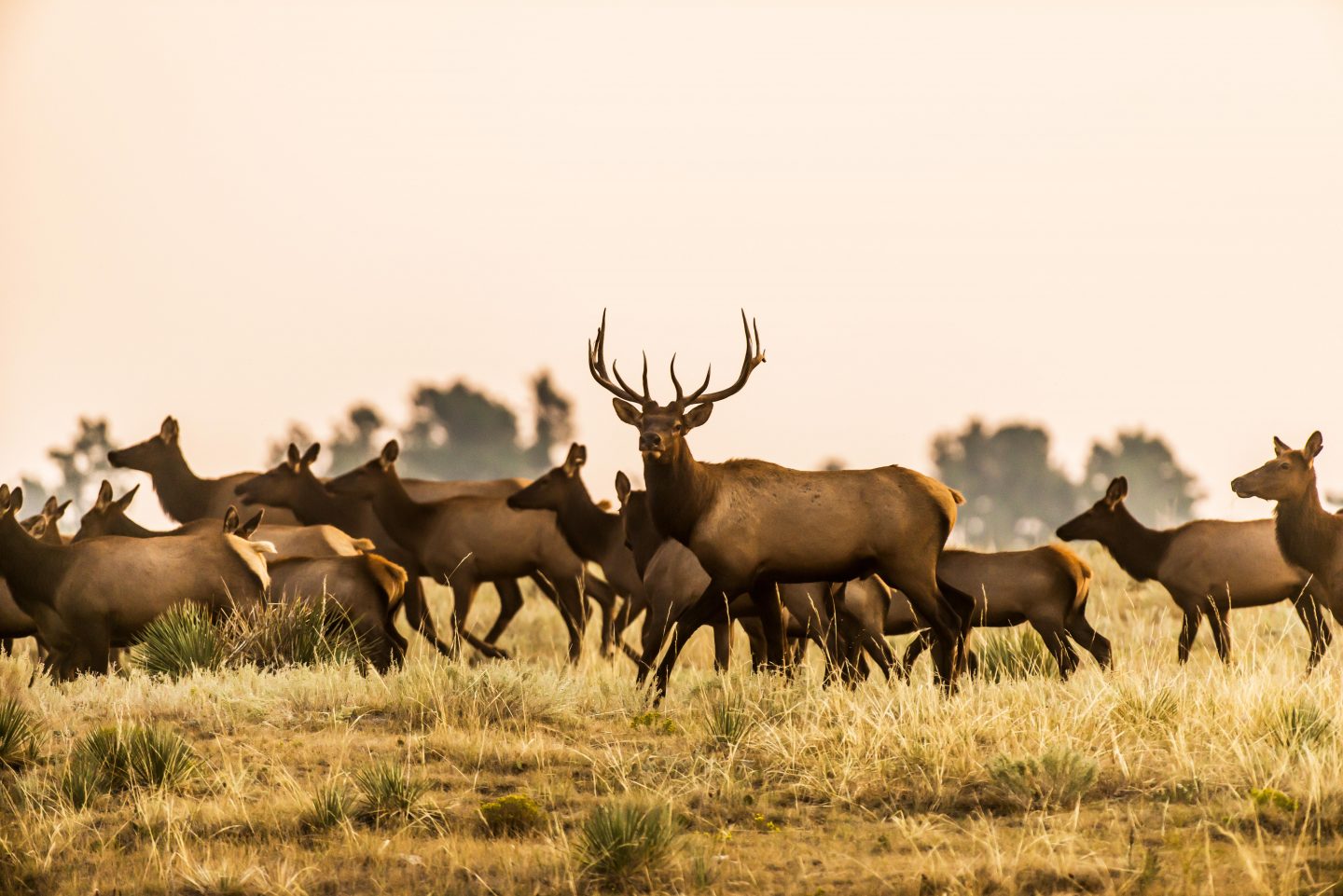
By Monica Macoubrie, Wildlife Education Specialist
As a child who watched plenty of movies, I’ve developed my own ideas about which animals fit certain personalities. For instance, snakes are often cast as villains — though I know better. Sloths are usually depicted as slow and less intellectually advanced. Elk, on the other hand, have always seemed like the enigmatic guardians of the forest or prairie, adding an air of mystery to them. Regardless of their cinematic roles, elk possess a hauntingly majestic presence with their eerie bugling and impressive size, making them larger than life on the Nebraska landscape.
Where Do Elk Fit In?
Elk, commonly called wapiti — a Native American word meaning “light-colored deer” — belong to the deer family (Cervidae). They are the second largest members, just behind moose. Male elk, or bulls, typically weigh between 700 and 1,200 pounds, standing about 4.5 to 5 feet tall at the shoulder. Females, known as cows, are smaller, averaging 500 to 600 pounds and standing around 4.5 feet tall.
Only males grow antlers, which they shed each spring and regrow in time for the fall mating season. A bull’s antlers can weigh up to 40 pounds! During growth, the antlers are covered in velvet, which supplies blood to the developing bone. In the summer, antlers can grow up to an inch per day, making them the fastest-growing bone in the animal kingdom. These impressive antlers signal dominance and demonstrate a bull’s ability to fend off predators and rival males, attracting females in the process.

History of Elk in Nebraska
Elk once roamed the Great Plains, including Nebraska, in large numbers, thriving in the diverse habitats of grasslands, river valleys and woodlands. These vast herds were an integral part of the ecosystem, playing a critical role in shaping the environment by grazing on vegetation and creating spaces for other wildlife to thrive.
Native American tribes, including the Lakota, Pawnee and Omaha, regularly encountered and relied on elk for sustenance, using their meat, hides and bones for food, clothing, shelter and tools. Elk held cultural significance for these tribes, and they were featured prominently in Native stories, rituals and traditions.
When European settlers began moving westward in the 19th century, Nebraska’s landscape —and its wildlife — began to change dramatically. The arrival of settlers brought widespread hunting and habitat destruction. Elk were hunted not only for their meat but also for their hides, antlers and bones, which were valuable resources in a growing frontier economy. Hunting became rampant, and large-scale market hunting, which supplied meat to cities and military outposts, led to sharp declines in elk populations.
By the late 1800s, elk had been nearly extirpated from Nebraska. Their numbers dwindled to the point where they were no longer a common sight, and in many regions of the state, they were completely gone. This pattern of decline mirrored what was happening to elk populations across much of the United States, with herds disappearing from large portions of their historical range.
In the 1960s, elk naturally started reoccurring in Nebraska, and by the 1980s, they were established in the Pine Ridge region, which still offered the open spaces and forests necessary for elk to thrive. This marked the beginning of a new chapter for elk in Nebraska, with populations slowly beginning to rebound. In 1986, Nebraska had its first modern elk hunting season. Since then, elk have expanded into the hills and rivers of western Nebraska, and the annual passage of young bulls through eastern Nebraska is a common occurrence. More than 4,000 elk have been harvested since the first season in 1986.

Elk Behavior and Habitat Needs
Elk in Nebraska exhibit a variety of behaviors and habitat preferences, which have been shaped by both the natural environment and human land use. Today, they are primarily found in the Pine Ridge region, the Niobrara River Valley and parts of western Nebraska, though their range has been expanding due to successful conservation efforts.
Elk in Nebraska are generalist feeders, adapting their diet to the seasons. In the warmer months, they graze on grasses, forbs and shrubs, which are abundant in Nebraska’s prairies and open woodlands. As winter approaches and vegetation becomes scarce, elk shift to browsing, feeding on woody plants such as twigs and bark. Their ability to switch between grazing and browsing allows them to survive in a wide range of habitats, from dense forests to grasslands and agricultural fields. In Nebraska, they often seek out riparian areas near rivers and streams, where they find a mix of open meadows and sheltering woodlands.
Habitat needs for elk in Nebraska vary, but they prefer areas with a combination of cover for protection and open spaces for foraging. Forested areas, such as those in the Pine Ridge and along the Niobrara River, provide shelter from predators and harsh weather, while adjacent meadows and prairies offer ample foraging opportunities. Water sources, including rivers, streams and wetlands, are essential for elk, particularly during the hotter months when they need to drink frequently. Additionally, elk in Nebraska often use agricultural fields, particularly during the winter months, to forage on leftover crops such as corn. This adaptability has allowed elk to thrive in fragmented landscapes, though it also brings them into occasional conflict with landowners.
The Fall Rut
As the crisp autumn air begins to settle over Nebraska’s prairies and forests, one of the most dramatic wildlife events of the year unfolds — the fall rut of the elk. This annual breeding season, typically from late September to early October, is a time of fierce competition, powerful displays and eerie vocalizations that fill the landscape.

At the heart of the fall rut is the haunting bugle call of the bull elk. This high-pitched, eerie sound can be heard echoing across the landscape during the early mornings and evenings. The bugle serves several purposes: It announces the presence of the bull to nearby females, or cows, and warns rival males to stay away. It is a sound that defines the season and underscores the power and majesty of these animals. Each bull’s bugle is unique, varying in pitch and length. This vocalization begins as a deep bellow, rises into a whistle and then descends into grunts.
One of the most dramatic aspects of the rut is the physical battles between bulls. These clashes involve bulls locking antlers in a fierce contest of strength and stamina. While these battles can sometimes result in injury, they rarely end in death. The primary goal is to assert dominance without unnecessary harm, with the victorious bull securing the chance to breed. As elk compete for dominance, they are also seeking to attract the most desirable females.
Bulls often roll in urine-soaked mud, covering themselves in scent. This not only acts as a cooling agent but also spreads a strong odor across their bodies, making them appear more intimidating to younger bulls looking to challenge their dominance. The larger and more dominant bulls gather harems of cows, which can range from a few to dozens, depending on the bull’s strength and territory.
The Cows
While much of the focus during the rut is on bulls, cows play an equally important role in this annual event. Female elk carefully evaluate the bulls, choosing mates based on their displays of strength, health and dominance. The strongest bulls, with the most impressive antlers and loudest bugles, are more likely to attract larger harems of cows, ensuring that their superior genetics are passed on to the next generation.
Cows also communicate with bulls through subtle vocalizations and body language, signaling when they are ready to mate. Their role in selecting mates ensures that the healthiest and most capable bulls pass on their traits, maintaining the overall fitness of the elk population.
Elk in Nebraska are a testament to successful conservation efforts and the state’s rich natural heritage. Once absent from the landscape, they have made a strong comeback, now thriving in various regions. As these majestic creatures continue to flourish, they remind us of the importance of preserving and managing Nebraska’s diverse ecosystems for future generations to enjoy.
